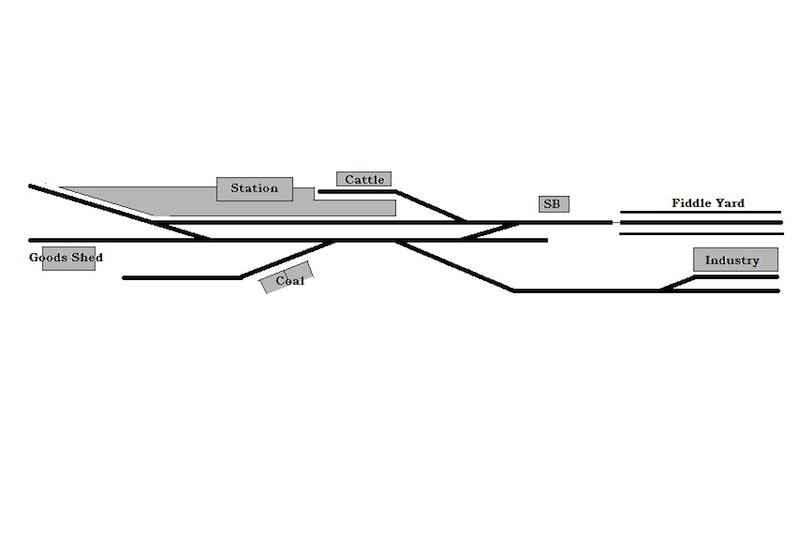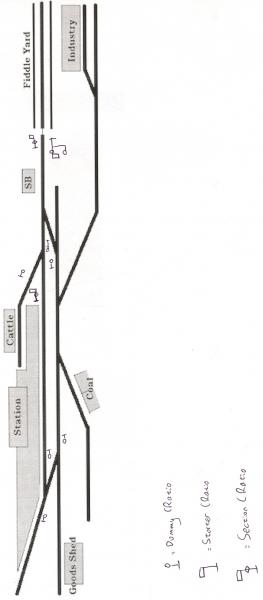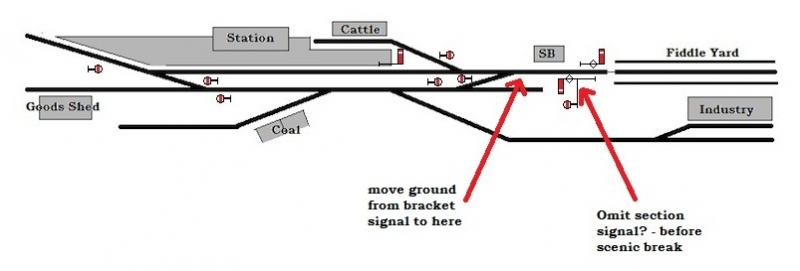Signalling help needed
Posted
#104115
(In Topic #5510)
Full Member
Here's a track plan of Much Murkle. I presume that a starter would be required on the end of the platform , but would there also need to be one for the cattle dock and loop? What about ground signals to control the goods sidings and also the industry branch, would that be signalled?
:hmmI could really do with some help here guys as I would like to buy the necessary bits when I go to Warley in a couple of weeks time.
Thanks in advance.

Posted
Guest user
What is right in one place is wrong in another. But if we are modelling fictitious localities we can interpret and extrapolate from reality as it suits us.
You are correct in assuming you will need a starter for the platform road. The cattle dock and run-round loop also feed directly onto the "main line" and could have starters fitted as well. If not they would require miniature arms at the least rather than shunting discs.
You could, if you so choose, place a three-arm bracket signal just on the station side of the signalbox. The centre arm would be on a taller post than the two either side as it would control the most important route but you then have all your three "starting" signals in one place. Equally they could all be on separate posts.
The latter option means they can all be placed before points are crossed; if you use the bracket signal then your "local instructions" would need to include only having one engine in steam to prevent any risk of two approaching the points together on a collision course based on the fact that they had not passed a stop signal. One-engine-in-steam (or one-train-working) would be very common on such small branches and does not preclude the existence of a second locomotive being "locked in" to the Industrial sidings as it would be protected by at least one stop signal.
Arriving from a single line you could justify an approach Home signal just onto the layout and with a token apparatus or somewhere for the signalman to stand and receive the token. That would be a single Home arm but probably with smaller shunting arms to admit trains to the cattle dock and loop.
You could also place a "Limit of Shunt" board just beyond your signalbox which would allow locomotives to run round (but not pass the board) without requiring the token for the single line ahead. They still need to pass a cleared starting signal but would not need to pass the (off-scene) advanced starter. Alternatively you can use shunting discs to permit the run-round move situated beneath the main home signal; these would only give authority to move as far as the "Limit" board
The Industry, Coal and Goods lines would require miniature arms to control exit to the more important line across the points.
Ground discs would be placed to control entry moves to the Coal and Industry sidings along the loop and also at the point on the headshunt where locos would diverge from the platform road to the loop at the buffer stop end and run round.
Two discs, one above the other, would be placed where the loop diverges to the Goods shed and loco headshunt; the top disc for the straight route to the Goods and the lower to the headshunt. As an alternative one disc with a miniature route indicator or two discs side by side would have the same meaning. If the Goods shed were considered the "main" route and trains were admitted to that unless signalled otherwise then you can get away with a single disc which would apply only for moves towards the headshunt.
Did I say signalling was a minefield?
The point at the entry to the Industry sidings may be under local control of a shunter or yard master and hand-worked by a lever there; as such no fixed signal would be required at this location in either direction. If it were remotely controlled from the signalbox (which is less likely) then again you will require a ground disc to give entry to the diverging route (only) and one each to control the exit onto the track leading off to the loop.
In reality most yards like that were not fully signalled and had such sidings under the operation of a shunter. No movement onto nor off the rest of the layout would be possible without first clearing the miniature arm approaching the run-round loop.
Posted
Full Member
Everything else was controlled by the shunter and signalman working together as a team.
How many engines in steam at the terminus would you have at one time. Probably no more than two. The shunter would be put aside while a passenger runs in and then around. Once the passenger has left the shunter comes back out to work again.
Posted
Guest user

Hope the above helps!
You will need: -
 x 2 (Starter and Section Signal)
x 2 (Starter and Section Signal) x 3 packs (To cover all shunt moves and adding to main signals where required)
x 3 packs (To cover all shunt moves and adding to main signals where required) x 1 to control access to the station (with one of the 465 signal also on bracket to left of main signal)
x 1 to control access to the station (with one of the 465 signal also on bracket to left of main signal)I can bring these with me if you wish?
Any questions about operation please ask.
Posted
Full Member
I know to whom I'll be addressing my 'sniggling' needs in due course.
Doug
 Last edit: by Chubber
Last edit: by Chubber
'You may share the labours of the great, but you will not share the spoil…' Aesop's Fables
"Beer is proof that God loves us and wants us to be happy" - Benjamin Franklin
In the land of the slap-dash and implausible, mediocrity is king
"Beer is proof that God loves us and wants us to be happy" - Benjamin Franklin
In the land of the slap-dash and implausible, mediocrity is king
Posted
Full Member
Thanks for the offer Chris. I already have an MSE kit for the starter and a Ratio signal kit but no ground signals. Are the ones you've shown Ratio? When I've finally worked out how many are needed I'll send you a PM.
Looking at the responses it seems that I have a number of options, I decided that I would like to keep it fairly simple (so that I have to build as few a signals as possible.) I found Chris's diagram a bit difficult to read so I've redone it. Have I got it right Chris?

There is a bridge at the scenic break so I'm wondering if the section signal on the bracket could be assumed to be before the bridge and therefore not needed. If this was the case would a ground signal be required to give access to the loop in the position shown below? I'll also assume that the industry line and the coal siding will be under the control of the shunter.

:cheers
 Last edit: by pnwood
Last edit: by pnwood
Posted
Guest user
I'm wondering if the section signal on the bracket could be assumed to be before the bridge and therefore not needed.
That is a fairly standard assumption on branch line terminus (BLT) layouts Nick. :thumbs
Posted
Full Member
Posted
Guest user
You have got it almost correct from my diagram. The bracket controlling access to the station does not have the section diamond on it, but another sub to control access to the platform when it is already partially occupied. You can have this signal quite close to the points almost opposite the signal box if you wish, or you can assume it is off-scene, which you can also do with the section signal guarding access to the single line.
The sub beside the point at the cattle dock should be double, with the top one giving access to the platform and the lower one giving access to the cattle dock. An example given below, but you of course only have two routes.

I should have mentioned that my plan assumes all the points on the goods loop are hand worked, except those giving access to the signalled routes.
Posted
Guest user
Alternatively you would need to operate with an authority to pass that signal. Either by clearing it and admitting the loco to the running line on the assumption that a token is already held for the single line section, or by use of a shunting disc admitting the loco only as far as a "Limit of Shunt" board as I mentioned.
There is more than one way to signal the layout; all the replies offer good advice.
Posted
Full Member
Chris, very happy for you to bring along to Warley a couple of packets of those Ratio ground signals. Am I right in thinking that you are on stand A30? I'll make myself known on the Sunday.
Nick
Posted
Guest user
One thing with your diagrams Nick - you need to site your section signal ("advanced starter" is another name for it) which admits trains to the single running line far enough away from the points that the longest-possible locomotive can run round and stop between the points and signal. If you can manage about a foot that gives plenty of space; there would be no fixed distance in reality so scaling down is not a big issue.
Alternatively you would need to operate with an authority to pass that signal. Either by clearing it and admitting the loco to the running line on the assumption that a token is already held for the single line section, or by use of a shunting disc admitting the loco only as far as a "Limit of Shunt" board as I mentioned.
There is more than one way to signal the layout; all the replies offer good advice.
Another way of doing what rick has described would be a subsidiary "shunt ahead" arm on the same post as the advanced starter, (quite common on the GWR).
This was a 3ft arm red in colour, (no white stripe) but they had a white letter "S" on the arm.
When cleared it allowed a shunting movement into the next block section as far as the "limit of shunt" post.
I am having to do this on my layout when the extension is built as there will not be enough room between the points and the advanced starter.
Hope this helps and not confuse!
Posted
Guest user
Posted
Full Member
Nick
Posted
Full Member
Obviously at a BLT not all points would be operated from the signal box. I know there may not be any hard and fast rules but which points are likely to have been controlled by the signalman and which by the use of point levers trackside?

I'm assuming that the loop points 1,3,4,& 7 would be controlled from the signal box, but is this likely to be correct. Would 4 & 7 be more likely to have been controlled by the fireman or guard?
If points 2, 5 & 6 were to be controlled by trackside levers, which side of the track would the lever be placed outside (red) or inside (blue) or doesn't it matter? I would have thought that 8 could be either side.
Hopefully one of you has some thoughts.
Thanks
Posted
Full Member
I am sure you will hear from others more knowlegeable than I but here is my quick reaction
I would be very surprised if point 2 was operated other than by the signalman ……and I am not that certain about 5 and 6………8 is, to me, the only solid candidate for a track side lever
Regards
Posted
Guest user
In many locations such points will also require a facing point lock which is also worked from the signalbox and interlocked with the point and signals. That prevents the signal being cleared for a move until the point is set and locked into the correct position.
Only No.8 points on your diagram would not by definition require signalbox control. Depending on local instructions, speed and volume of traffic then Nos. 5 and 6 might also be worked by the shunter throwing a lever though possibly under the authority of the signalman.
Point levers would normally be placed on the "straight" side but not always - some points are curved in both directions for example or the location might make clearance an issue.
It would not be normal practice for footplate crew to operate points if a shunter were employed at the location and they would need the authority of a signalman to do so in any case. In places where a signal box was not provided the loco crew might be deemed to have authority to change points if - for example - they held a single line token which included a point key to unlock a ground frame or single point to allow a run-round at a rural terminus.
Posted
Full Member
A comprehensive response Rick and makes complete sense. Point 8 only it is then.
Always grateful for the help and opportunity to learn from all of you.
:cheers
1 guest and 0 members have just viewed this.

